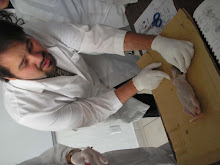energy: "ability or capacity to do work"
chemical energy: it is storage between bonds, and it can be realize in fo
rm of light, fire, etc
organelles: parts that form a cell
this class we talked about
mitochondria:

-found in animal and plant cells
-this organelle is compose by an outer membrane and an inter membrane,inside the inter membrane there are ions and fluids (the juicy part of the mitochondria, haha)
-main function: to produce ATP (adenosinetriphosphate -main source of energy-) by taking glucose, this way energy is release
-content mitochondrial DNA
chloroplast:
-found only in plant cells
-takes energy from the sun this way it can make the photosynthesis (the way plant make food for themselves and release oxygen)
-the chloroplast main structure is tylatoid.
- content chloroplast DNA
picture we talked about endosymbiotic theory propose by Lynn Margulis
tells that the eukaryotic cells are an evolution of the prokaryotic cell, that happened millions of year ago, this process was caused by the symbiotic process, that is the relationship of interdependence that exist between prokariotic cells, a prokaryotic cell was to close to another one, by the pass of the time some prokaryotic cells was getting together with other, the prokariotic cells stacked inside the biggest cell form the organelles, this way this cells have a double membrane..
this theory can be prove because:
-the size of some organelles (ex. mitochondria) is consistent with some of the prokariotic cells
-the genome: have two very different kind of DNA, as if they came from different organism
-and the organism still attacking the mitochondria as if it was an strange object
you can also visit this page:
http://www.isepp.org/Pages/San%20Jose%2004-05/MargulisSaganSJ.html
here are hers scientific contributions
you can also visit this page:
http://www.isepp.org/Pages/
here are hers scientific contributions
concept you should know:(like glossary)
>organelle:A membrane-delimited compartment found inside eukaryotic cells, such as mitochondria, the nucleus and vacuoles
en.wiktionary.org/wiki/organelle
en.wiktionary.org/wiki/
>ribosomes: Cell organelles that translate RNA to build proteins.
www.bio-medicine.org/biology-technology/Glossary-for-The-BioPharm-Guide-to-Fermentation-and-Cell-Culture-1542-12/
www.bio-medicine.org/biology-
>energy: The capacity for work. /The ability to do work, or produce change.
>glucose: a monosaccharide sugar that has several forms; an important source of physiological energy
wordnetweb.princeton.edu/perl/webwn
wordnetweb.princeton.edu/perl/
>membrane: regulates what comes in and what comes out in cell, delimits the boundaries of the cell
>endosymbiotic theory: the origins of mitochondria and plastids (e.g. chloroplasts), which are organelles of eukaryotic cells. According to this theory, these organelles originated as separate prokaryotic organisms which were taken inside the cell.
en.wikipedia.org/wiki/Endosymbiotic_theory
en.wikipedia.org/wiki/
>symbiosis: the relation between two different species of organisms that are interdependent; each gains benefits from the other
wordnetweb.princeton.edu/perl/webwn
wordnetweb.princeton.edu/perl/
>genome: The genetic material of an organism. (DNA and RNA)
nationalzoo.si.edu/Animals/Primates/glossary.cfm
nationalzoo.si.edu/Animals/
>prokaryotic cell: A cell that lacks organelles. Bacteria and Archaea.
blue.utb.edu/biology/oliva/terms_and_definitions_for_quiz_1.htm
blue.utb.edu/biology/oliva/
>eukaryotic cell: cells are organized into complex structures enclosed within membranes. Most living organisms, including all animals, plants, fungi, and protists.
en.wikipedia.org/wiki/Eukaryotic_cell
en.wikipedia.org/wiki/
and the homework
what does "endo-" means?
what is a membrane?
what is a system?
Juana Montoya


No hay comentarios:
Publicar un comentario